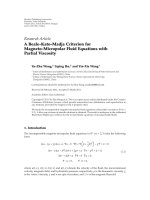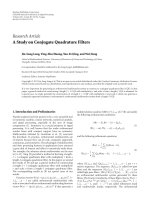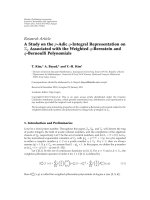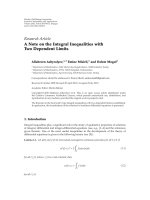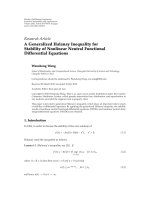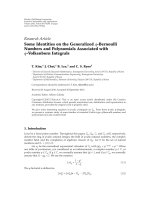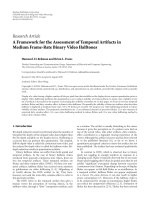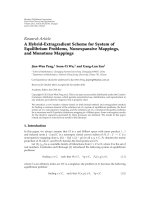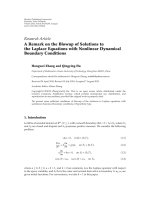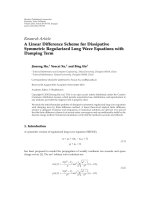Báo cáo hóa học: " Research Article A Note on the Relaxation-Time Limit of the Isothermal Euler Equations" pdf
Bạn đang xem bản rút gọn của tài liệu. Xem và tải ngay bản đầy đủ của tài liệu tại đây (527.67 KB, 10 trang )
Hindawi Publishing Corporation
Boundary Value Problems
Volume 2007, Article ID 56945, 10 pages
doi:10.1155/2007/56945
Research Article
A Note on the Relaxation-Time Limit of
the Isothermal Euler Equations
Jiang Xu and Daoyuan Fang
Received 3 July 2007; Accepted 30 August 2007
Recommended by Patrick J. Rabier
This work is concerned with the relaxation-time limit of the multidimensional isothermal
Euler equations with relaxation. We show that Coulombel-Goudon’s results (2007) can
hold in the weaker and more general Sobolev space of fractional order. The method of
proof used is the Littlewood-Paley decomposition.
Copyright © 2007 J. Xu and D. Fang. This is an open access article distributed under the
Creative Commons Attribution License, which permits unrestricted use, distribution,
and reproduction in any medium, provided the original work is properly cited.
1. Introduction
The multidimensional isothermal Euler equation w ith relaxation describing the perfect
gas flow is given by
n
t
+ ∇·(nu) = 0,
(nu)
t
+ ∇·(nu ⊗u)+∇p(n) =−
1
τ
nu
(1.1)
for (t,x)
∈ [0,+∞) ×R
d
, d ≥ 3, where n, u = (u
1
,u
2
, ,u
d
)
( represents transpose)
denote the density and velocity of the flow, respectively, and the constant τ is the mo-
mentum relaxation time for some physical flow. Here, we assume that 0 <τ
≤ 1. The
pressure p(n) satisfies p(n)
= An,andA>0 is a physical constant. The symbols ∇, ⊗are
the gradient operator and the symbol for the tensor products of two vectors, respectively.
The system is supplemented with the initial data
(n,u)(x,0)
=
n
0
,u
0
(x), x ∈ R
d
. (1.2)
2 Boundary Value Problems
To be concerned with the small relaxation-time analysis, we define the scaled variables
n
τ
,u
τ
(x, s) =(n,u)
x,
s
τ
. (1.3)
Then the new variables satisfy the following equations:
n
τ
s
+ ∇·
n
τ
u
τ
τ
=
0,
τ
2
n
τ
u
τ
τ
s
+ τ
2
n
τ
u
τ
⊗u
τ
τ
2
+
n
τ
u
τ
τ
=−A∇n
τ
(1.4)
with initial data
n
τ
,u
τ
(x,0) =
n
0
,u
0
. (1.5)
Let τ
→ 0, formally, we obtain the heat equation
ᏺ
s
−AΔᏺ = 0,
ᏺ(x,0)
= n
0
.
(1.6)
The above formal derivation of heat equation has been justified by many authors, see
[1–3] and the references therein. In [2], Junca and Rascle studied the convergence of the
solutions to (1.1) towards those of (1.6) for arbitrary large initial data in BV(
R)space.
Marcati and Milani [3] showed the derivation of the porous media equation as the limit of
the isentropic Euler equations in one space dimension. Recently, Coulombel and Goudon
[1] constructed the uniform smooth solutions to (1.1) in the multidimensional case and
proved this relaxation-time limit in some Sobolev space H
k
(R
d
)(k>1+d/2, k ∈ N). In
this paper, we weaken the regularity assumptions on the initial data and establish a similar
relaxation result in the more general Sobolev space of fractional order (H
σ+ε
(R
d
), σ =
1+d/2, ε>0) with the aid of Littlewood-Paley decomposition theory.
If fixed τ>0, there are some efforts on the global existence of smooth solutions to the
system (1.1)-(1.2) for the isentropic gas or the general hyperbolic system, the interested
readers can refer to [4–7]. Now, we state main results as follows.
Theorem 1.1. Let
n be a constant reference density. Suppose that n
0
−n and u
0
∈H
σ+ε
(R
d
),
there exist two positive constants δ
0
and C
0
independent of τ such that if
n
0
−n,u
0
2
H
σ+ε
(R
d
)
≤ δ
0
, (1.7)
then the system (1.1)-(1.2) admits a unique global solution (n,u) satisfying
(n
−n,u) ∈Ꮿ
[0,∞),H
σ+ε
R
d
. (1.8)
J. Xu and D. Fang 3
Moreover, the uniform energy inequality holds:
(n −n,u)(·,t)
2
H
σ+ε
(R
d
)
+
1
τ
t
0
u(·,σ)
2
H
σ+ε
(R
d
)
dσ + τ
t
0
(∇n,∇u)(·,σ)
2
H
σ−1+ε
(R
d
)
dσ
≤ C
0
n
0
−n,u
0
2
H
σ+ε
(R
d
)
, t ≥ 0.
(1.9)
Based on Theorem 1.1, using the standard weak convergence method and compact-
ness theorem [8], we can obtain the fol lowing relaxation-time limit immediately.
Corollary 1.2. Let (n,u) be the global solution of Theorem 1.1, then
n
τ
−n is uniformly bounded in Ꮿ
[0,∞),H
σ+ε
R
d
,
n
τ
u
τ
τ
is uniformly bounded in L
2
[0,∞),H
σ+ε
R
d
.
(1.10)
Further more, there exists some function ᏺ
∈ Ꮿ([0,∞),n + H
σ+ε
(R
d
)) which is a global
weak solution of (1.6). For any time T>0,wehaven
τ
(x, s) strongly converges to ᏺ(x,s)
in Ꮿ([0,T],(H
σ
+ε
(R
d
))
loc
)(σ
<σ) as τ → 0.
2. Preliminary lemmas
On the Littlewood-Paley decomposition and the definitions of Besov space, for brevity,
we omit the details, see [9]or[7]. Here, we only present some useful lemmas.
Lemma 2.1 ([9, 7]). Let s>0 and 1
≤ p,r ≤∞. Then B
s
p,r
∩L
∞
is an algebra and one has
fg
B
s
p,r
f
L
∞
g
B
s
p,r
+ g
L
∞
f
B
s
p,r
if f ,g ∈ B
s
p,r
∩L
∞
. (2.1)
Lemma 2.2 [9, 7]. Let 1
≤ p,r ≤∞,andI be open interval of R.Lets>0 and be the small-
est integer such that
≥ s.LetF : I → R satisfy F(0) = 0 and F
∈ W
,∞
(I;R). Assume that
v
∈ B
s
p,r
takes values in J ⊂⊂I. Then F(v) ∈ B
s
p,r
and there exists a constant C depending
only on s, I, J,andd such that
F(v)
B
s
p,r
≤ C
1+v
L
∞
F
W
,∞
(I)
v
B
s
p,r
. (2.2)
Lemma 2.3 [7]. Let s>0, 1 <p<
∞, the following inequalities hold.
(I) q
≥−1:
2
qs
f ,Δ
q
Ꮽg
L
p
≤
⎧
⎪
⎪
⎪
⎪
⎪
⎪
⎪
⎪
⎪
⎨
⎪
⎪
⎪
⎪
⎪
⎪
⎪
⎪
⎪
⎩
Cc
q
f
B
s
p,2
g
B
s
p,2
, f , g ∈B
s
p,2
, s =1+
d
p
+ ε (ε>0),
Cc
q
f
B
s
p,2
g
B
s+1
p,2
, f ∈ B
s
p,2
, g ∈B
s+1
p,2
, s =
d
p
+ ε (ε>0),
Cc
q
f
B
s+1
p,2
g
B
s
p,2
, f ∈ B
s+1
p,2
, g ∈B
s
p,2
, s =
d
p
+ ε (ε>0).
(2.3)
4 Boundary Value Problems
If f
= g, then
2
qs
f ,Δ
q
Ꮽg
L
p
≤ Cc
q
∇f
L
∞
g
B
s
p,2
, s>0. (2.4)
(II) q
=−1:
2
−s
f ,Δ
q
Ꮽg
L
2d/(d+2)
≤ Cc
−1
f
B
s
2,2
g
B
s
2,2
, f ,g ∈B
s
2,2
, s =1+
d
2
+ ε (ε>0),
(2.5)
where the operator Ꮽ
= div or ∇, the commutator [ f ,h] = fh−hf, C is a harmless con-
stant, and c
q
denotes a sequence such that (c
q
)
l
1
≤ 1. (In particular, Besov space B
s
2,2
≡
H
s
.)
3. Reformulation and local existence
Let us introduce the enthalpy Ᏼ(ρ)
= Aln ρ (ρ > 0), and set
m(t,x)
= A
−1/2
Ᏼ
n(t,x)
−
Ᏼ(n)
. (3.1)
Then (1.1) can be transformed into the symmetric hyperbolic form
∂
t
U +
d
j=1
A
j
(u)∂
x
j
U =−
1
τ
0
u
, (3.2)
where
U
=
m
u
, A
j
(u) =
u
j
√
Ae
j
√
Ae
j
u
j
. (3.3)
The initial data (1.2)becomeinto
U
0
=
√
A
lnn
0
−lnn
,u
0
. (3.4)
Remark 1. The variable change is from the open set
{(n,u) ∈ (0,+∞) ×R
d
} to the whole
space
{(m,u) ∈ R
d
×R
d
}. It is easy to show that the system (1.1)-(1.2)isequivalentto
(3.2)–(3.4) for classical solutions (n,u) away from vacuum.
First, we recall a local existence and u niqueness result of classical solutions to (3.2)–
(3.4) which has been obtained in [7].
Proposition 3.1. For any fixed relaxation time τ>0, assume that U
0
∈ B
σ
2,1
, then there
exist a time T
0
> 0 (only depending on the initial data U
0
)andauniquesolutionU(t,x) to
(3.2)–(3.4) such that U
∈ Ꮿ
1
([0,T
0
] ×R
d
) and U ∈Ꮿ([0,T
0
],B
σ
2,1
) ∩Ꮿ
1
([0,T
0
],B
σ−1
2,1
).
J. Xu and D. Fang 5
4. A priori estimate and global existence
In this section, we will establish a uniform a priori estimate, which is used to derive the
global existence of classical solutions to (3.2)–(3.4). Defining the energy function
E
τ
(T)
2
:= sup
0≤t≤T
U(t)
2
H
σ+ε
+
1
τ
T
0
u(t)
2
H
σ+ε
dt + τ
T
0
∇
x
U(t)
2
H
σ−1+ε
dt,
(4.1)
then we have the following a priori estimate.
Proposition 4.1. For any given time T>0,ifU
∈ Ꮿ([0,T],H
σ+ε
) is a s olution to the
system (3.2)–(3.4), then the following inequalit y holds:
E
τ
(T)
2
≤ C
S(T)
E
τ
(0)
2
+ E
τ
(T)
2
+ E
τ
(T)
4
, (4.2)
where S(T)
= sup
0≤t≤T
U(·,t)
H
σ+ε
, C(S(T)) denotes an increasing function from R
+
to
R
+
, which is inde pendent of τ,T, U.
Proof. The proof of Proposition 4.1 is divided into two steps. First, we estimate the
L
∞
([0,T],H
σ+ε
)normofU, and the L
2
([0,T],H
σ+ε
)oneofu. Then, we estimate the
L
2
([0,T],H
σ−1+ε
)normof∇U.
Step 1. Applying the operator Δ
q
to (3.2), multiplying t he resulting equations by Δ
q
m
and Δ
q
u, respectively, and then integrating them over R
d
,weget
1
2
Δ
q
m
2
L
2
+
Δ
q
u
2
L
2
t
0
+
1
τ
t
0
Δ
q
u(σ)
2
L
2
dσ
=
1
2
t
0
R
d
divu
Δ
q
m
2
+
Δ
q
u
2
dxdσ
+
t
0
R
d
u,Δ
q
·∇
mΔ
q
m +
u,Δ
q
·∇
uΔ
q
u
dxdσ.
(4.3)
In what follows, we first deal with the low-frequency case. By performing integration by
parts, then using H
¨
older- and Gagliardo-Nirenberg-Sobolev inequality, we have (d
≥ 3)
Δ
−1
m
2
L
2
+
Δ
−1
u
2
L
2
t
0
+
2
τ
t
0
Δ
−1
u(σ)
2
L
2
dσ
≤
t
0
2u
L
d
Δ
−1
m
L
2d/(d−2)
Δ
−1
∇m
L
2
+ ∇u
L
∞
Δ
−1
u
2
L
2
dσ
+2
t
0
u,Δ
−1
·∇
m
L
2d/(d+2)
Δ
−1
m
L
2d/(d−2)
+
u,Δ
−1
·∇
u
L
2
Δ
−1
u
L
2
dσ
≤
t
0
2
u
L
d
Δ
−1
∇m
2
L
2
+
∇
u
L
∞
Δ
−1
u
2
L
2
dσ
+2
t
0
u,Δ
−1
·∇
m
L
2d/(d+2)
Δ
−1
∇m
L
2
+
u,Δ
−1
·∇
u
L
2
Δ
−1
u
L
2
dσ.
(4.4)
6 Boundary Value Problems
Multiplying the factor 2
−2(σ+ε)
on both sides of (4.4), from Lemma 2.3 and Young in-
equality, we obtain
2
−2(σ+ε)
Δ
−1
m
2
L
2
+
Δ
−1
u
2
L
2
t
0
+
2
τ
t
0
2
−2(σ+ε)
Δ
−1
u(σ)
2
L
2
dσ
≤
t
0
1
2
u
L
d
2
−2(σ−1+ε)
Δ
−1
∇m
2
L
2
+ ∇u
L
∞
2
−2(σ+ε)
Δ
−1
u
2
L
2
dσ
+ C
t
0
c
−1
u
H
σ+ε
m
H
σ+ε
2
−(σ−1+ε)
Δ
−1
∇m
L
2
+ c
−1
u
2
H
σ+ε
2
−(σ+ε)
Δ
−1
u
L
2
dσ
≤
t
0
1
2
u
L
d
2
−2(σ−1+ε)
Δ
−1
∇m
2
L
2
+ ∇u
L
∞
2
−2(σ+ε)
Δ
−1
u
2
L
2
dσ
+ C
t
0
m
H
σ+ε
1
τ
c
2
−1
u
2
H
σ+ε
+ τ2
−2(σ−1+ε)
Δ
−1
∇m
2
L
2
dσ
+ C
t
0
u
H
σ+ε
1
τ
c
2
−1
u
2
H
σ+ε
+
1
τ
2
−2(σ+ε)
Δ
−1
u
2
L
2
dσ
τ ≤
1
τ
,
(4.5)
where C is some positive constant independent of τ. For the high-frequency case, we can
also achieve the similar inequality:
2
2q(σ+ε)
Δ
q
m
2
L
2
+
Δ
q
u
2
L
2
t
0
+
2
τ
t
0
2
2q(σ+ε)
Δ
q
u(σ)
2
L
2
dσ
≤ C
t
0
∇u
L
∞
2
2q(σ−1+ε)
Δ
q
∇m
2
L
2
+2
2q(σ+ε)
Δ
q
u
2
L
2
dσ
+ C
t
0
m
H
σ+ε
1
τ
c
2
q
u
2
H
σ+ε
+ τ2
2q(σ−1+ε)
Δ
q
∇m
2
L
2
dσ
+ C
t
0
u
H
σ+ε
1
τ
c
2
q
u
2
H
σ+ε
+
1
τ
2
2q(σ+ε)
Δ
q
u
2
L
2
dσ
τ ≤
1
τ
,
(4.6)
where we have taken the advantage of the fact
Δ
q
∇m
L
2
≈ 2
q
Δ
q
m
L
2
(q ≥ 0).
By summing (4.6)onq
∈ N ∪{0} and adding (4.5) together, then according to the
imbedding property in Sobolev space, we have
m
2
H
σ+ε
+ u
2
H
σ+ε
t
0
+
2
τ
t
0
u
2
H
σ+ε
dσ
≤ C
t
0
m
H
σ+ε
1
τ
u
2
H
σ+ε
+ τ∇m
2
H
σ−1+ε
dσ + C
t
0
u
H
σ+ε
1
τ
u
2
H
σ+ε
dσ
+ C
t
0
m
H
σ+ε
1
τ
u
2
H
σ+ε
+ τ∇m
2
H
σ−1+ε
dσ
+ C
t
0
u
H
σ+ε
1
τ
u
2
H
σ+ε
+
1
τ
u
2
H
σ+ε
dσ.
(4.7)
J. Xu and D. Fang 7
Therefore, for any t
∈ [0,T], the following inequality holds:
U(t)
2
H
σ+ε
+
2
τ
t
0
u
2
H
σ+ε
dσ ≤ C
S(t)
E
τ
(0)
2
+ E
τ
(t)
2
. (4.8)
Step 2. Thanks to the important skew-symmetric lemma developed in [1, 6, 10], we are
going to estimate the L
2
([0,T],H
σ−1+ε
)normof∇U.
Lemma 4.2 (Shizuta-Kawashima). For all ξ
∈ R
d
, ξ = 0, the system (3.2) admits a real
skew-symme tric smooth matrix K(ξ) which is defined in the unit sphe re S
d−1
:
K(ξ)
=
⎛
⎜
⎜
⎝
0
ξ
|ξ|
−
ξ
|ξ|
0
⎞
⎟
⎟
⎠
, (4.9)
then
K(ξ)
d
j=1
ξ
j
A
j
(0) =
⎛
⎜
⎝
√
A|ξ| 0
0
−
√
A
ξ
⊗ξ
|ξ|
⎞
⎟
⎠
. (4.10)
The system (3.2)canbewrittenasthelinearizedform
∂
t
U +
d
j=1
A
j
(0)∂
x
j
U =
d
j=1
A
j
(0) −A
j
(u)
∂
x
j
U −
1
τ
0
u
. (4.11)
Let
Ᏻ
=
d
j=1
A
j
(0) −A
j
(u)
∂
x
j
U. (4.12)
From Lemma 2.1,wehave
Ᏻ
H
σ−1+ε
≤ Cu
H
σ−1+ε
∇U
H
σ−1+ε
. (4.13)
Apply the operator Δ
q
to the system (4.11)toget
∂
t
Δ
q
U +
d
j=1
A
j
(0)∂
x
j
Δ
q
U = Δ
q
Ᏻ −
1
τ
0
Δ
q
u
. (4.14)
By performing the Fourier transform w ith respect to the space variable x for (4.14)and
multiplying the resulting equation by
−iτ(
Δ
q
U)
∗
K(ξ), “∗” represents transpose and
conjugator, then taking the real part of each term in the equality, we can obtain
τ Im
Δ
q
U
∗
K(ξ)
d
dt
Δ
q
U
+ τ
Δ
q
U
∗
K(ξ)
d
j=1
ξ
j
A
j
(0)
Δ
q
U
=−Im
Δ
q
m
∗
ξ
|ξ|
Δ
q
u
+ τ Im
Δ
q
U
∗
K(ξ)
Δ
q
Ᏻ
.
(4.15)
8 Boundary Value Problems
Using the skew-symmetry of K(ξ), we have
Im
Δ
q
U
∗
K(ξ)
d
dt
Δ
q
U
=
1
2
d
dt
Im
Δ
q
U
∗
K(ξ)
Δ
q
U
. (4.16)
Substituting (4.10) into t he second term on the left-hand side of (4.15), it is not difficult
to get
τ Im
Δ
q
U
∗
K(ξ)
d
dt
Δ
q
U
+ τ
Δ
q
U
∗
K(ξ)
d
j=1
ξ
j
A
j
(0)
Δ
q
U
≥
τ
2
d
dt
Im
Δ
q
U
∗
K(ξ)
Δ
q
U
+ τ
√
A|ξ|
Δ
q
U
2
−2
√
A|ξ|
Δ
q
u
2
.
(4.17)
With the help of Young inequalit y, the right-hand side of (4.15)canbeestimatedas
−Im
Δ
q
m
∗
ξ
|ξ|
Δ
q
u
+ τ Im
Δ
q
U
∗
K(ξ)
Δ
q
Ᏻ
≤
τ
√
A
2
|ξ|
Δ
q
U
2
+
C
τ|ξ|
Δ
q
u
2
+
Cτ
|ξ|
Δ
q
Ᏻ
2
,
(4.18)
where the positive constant C is independent of τ. Combining with the equality (4.15)
and the inequalities (4.17)-(4.18), we deduce
τ
√
A
2
|ξ|
Δ
q
U
2
≤
C
τ
|
ξ|+
1
|ξ|
Δ
q
u
2
+
Cτ
|ξ|
Δ
q
Ᏻ
2
−
τ
2
d
dt
Im
Δ
q
U
∗
K(ξ)
Δ
q
U
.
(4.19)
Multiplying (4.19)by
|ξ| and integrating it over [0,t] ×R
d
, from Plancherel’s theorem,
we reach
τ
t
0
Δ
q
∇U
2
L
2
dσ ≤
C
τ
t
0
Δ
q
u
2
L
2
+
Δ
q
∇u
2
L
2
dσ + Cτ
t
0
Δ
q
Ᏻ
2
L
2
dσ
−
τ
2
Im
R
d
|ξ|
Δ
q
U
∗
K(ξ)
Δ
q
U
dξ
t
0
≤
C
τ
t
0
2
2q
Δ
q
u
2
L
2
dσ + Cτ
t
0
Δ
q
Ᏻ
2
L
2
dσ
+ Cτ2
2q
Δ
q
U(t)
2
L
2
+
Δ
q
U(0)
2
L
2
,
(4.20)
where we have used the uniform boundedness of the matrix K(ξ)(ξ
= 0).
Multiplying the factor 2
2q(σ−1+ε)
(q ≥−1) on both sides of (4.20) and summing it on
q,wehave
τ
t
0
∇U
2
H
σ−1+ε
dσ ≤
C
τ
t
0
u
2
H
σ+ε
dσ + Cτ
t
0
Ᏻ
2
H
σ−1+ε
dσ + Cτ
U(t)
2
H
σ+ε
+
U(0)
2
H
σ+ε
≤
C
S(t)
E
τ
(0)
2
+ E
τ
(t)
2
+ E
τ
(t)
4
.
(4.21)
J. Xu and D. Fang 9
Together with the inequalities (4.8)and(4.21), (4.2) follows immediately, which com-
pletes the proof of Proposition 4.1.
Proof of Theorem 1.1. In fact, Proposition 3.1 also holds on the framework of the func-
tional space H
σ+ε
(≡ B
σ+ε
2,2
). There exists a sufficiently small number
0
independent of τ
such that E
τ
(T) ≤
0
≤ 1from(4.1), we have
E
τ
(T)
2
≤
C
E
τ
(0)
2
+ E
τ
(T)
3
, (4.22)
where the constant
C is independent of τ. Without loss of generality, we may assume
C ≥ 1. Similar to that in [1], we achieve that
E
τ
(t) ≤ min
0
,
1
2
C
,
2
CE
τ
(0)
(4.23)
for any t
≥ 0if
U
0
H
σ+ε
≤
1
2(2
C)
3/2
. (4.24)
Note that the density
n
−n = n
exp
A
−1/2
m
−
1
; (4.25)
from Lemma 2.2, the definition of E
τ
(t), and the standard continuity argument, we can
obtain the following result: there exist two positive constants δ
0
, C
0
independent of τ if
the initial data satisfy
n
0
−n
2
H
σ+ε
+
u
0
2
H
σ+ε
≤ δ
0
, (4.26)
then the system (1.1)-(1.2) exists as a unique global solution (n,u). Moreover, the uni-
form energy estimate holds:
(n −n,u)(·,t)
2
H
σ+ε
+
1
τ
t
0
u(·,σ)
2
H
σ+ε
dσ + τ
t
0
(∇n,∇u)(·,σ)
2
H
σ−1+ε
dσ
≤ C
0
n
0
−n,u
0
2
H
σ+ε
, t ≥ 0,
(4.27)
which completes the proof of Theorem 1.1.
The proof of Corollary 1.2 is similar to that in [1]; here, we omit the details, the inter-
ested readers can refer to [1].
Acknowledgments
This work was supported by NUAA’s Scientic Fund for the Introduction of Qualified Per-
sonnel (S0762-082), NSFC 10571158, and Zhejiang Provincial NSF of China (Y605076).
10 Boundary Value Problems
References
[1] J F. Coulombel and T. Goudon, “The strong relaxation limit of the multidimensional isother-
mal Euler equations,” Transactions of the American Mathematical Society, vol. 359, no. 2, pp.
637–648, 2007.
[2] S. Junca and M. Rascle, “Strong relaxation of the isothermal Euler system to the heat equation,”
Zeitschrift f
¨
ur Angewandte Mathematik und Physik, vol. 53, no. 2, pp. 239–264, 2002.
[3] P. Marcati and A. Milani, “The one-dimensional Darcy’s law as the limit of a compressible Euler
flow,” Journal of Differential Equations, vol. 84, no. 1, pp. 129–147, 1990.
[4] B. Hanouzet and R. Natalini, “Global existence of smooth solutions for partially dissipative hy-
perbolicsystemswithaconvexentropy,”Archive for Rational Mechanics and Analysis, vol. 169,
no. 2, pp. 89–117, 2003.
[5] T. C. Sideris, B. Thomases, and D. Wang, “Long time behavior of solutions to the 3D compress-
ible Euler with damping,” Communications in Partial Di fferential Equations,vol.28,no.3-4,pp.
795–816, 2003.
[6] W A. Yong, “Entropy and global existence for hyperbolic balance laws,” Archive for Rational
Mechanics and Analysis, vol. 172, no. 2, pp. 247–266, 2004.
[7] D. Y. Fang and J. Xu, “Existence and asymptotic behavior of C
1
solutions to the multidimen-
sional compressible Euler equations with damping,” />[8] J. Simon, “Compact sets in the space L
p
(0,T;B),” Annali di Matematica Pura ed Applicata,
vol. 146, no. 1, pp. 65–96, 1987.
[9] J Y. Chemin, Perfect Incompressible Fluids, vol. 14 of Oxford Lecture Series in Mathematics and
Its Applications, The Clarendon Press, Oxford University Press, New York, NY, USA, 1998.
[10] Y. Shizuta and S. Kawashima, “Systems of equations of hyperbolic-parabolic type with applica-
tions to the discrete Boltzmann equation,” Hokkaido Mathematical Journal,vol.14,no.2,pp.
249–275, 1985.
Jiang Xu: Department of Mathematics, Nanjing University of Aeronautics and Astronautics,
Nanjing 210016, China
Email address: jiangxu
Daoyuan Fang: Department of Mathematics, Zhe j iang University, Hangzhou 310027, China
Email address:
